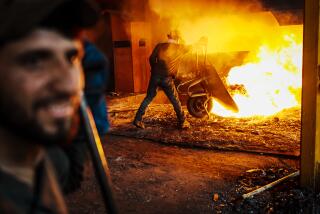White House wants more aid for Afghanistan
WASHINGTON — The Bush administration will seek $10.6 billion more in aid for Afghanistan, Secretary of State Condoleezza Rice said Thursday, in another sign that the White House is deepening its commitment in the Central Asian nation in response to growing concern over a Taliban resurgence.
The proposal for additional money came the same week the Pentagon announced plans to extend the deployment of 3,200 troops in the country and amid a broad rethinking of the American strategy for dealing with Afghanistan.
The new aid, which would be spent over two years, would mark a substantial addition to the $14 billion the United States has spent in Afghanistan since the invasion that toppled the Taliban’s fundamentalist Islamic government in late 2001. About $8.6 billion of the new funding would be used to train and arm Afghan troops and police, and the remainder would be for reconstruction, including new roads, electricity and other infrastructure, Rice told reporters during a trip to Brussels.
“The challenges of the last several months have demonstrated that we want to, and should, redouble our efforts,” she said.
U.S. officials have become increasingly alarmed by the resurgence of the Taliban, whose attacks on the fragile government and international forces made 2006 the bloodiest year since the U.S.-led invasion, with 4,000 deaths from violence. Military strategists are preparing for an expected spring campaign by the Taliban forces.
A senior U.S. official, speaking to reporters last week, said that prospects for progress in the Afghan effort were far better than in Iraq. Even so, he said, “efforts in Afghanistan need desperately to be intensified.”
The official, who would discuss U.S. strategy only on condition of anonymity, said the United States and its NATO allies needed a “comprehensive approach” that included not only stepped-up security, but also efforts to strengthen the weak economy, fight the opium trade and extend the reach of a government that is hardly in evidence in many parts of the country.
As part of the effort to stabilize the country, the U.S. is temporarily increasing the size of its force there by postponing the return of the 3rd Brigade of the 10th Mountain Division. The brigade, based at Ft. Drum, N.Y., will be extended by up to 120 days beyond its one-year deployment, the Pentagon said this week. Taking into account service members being rotated out of Afghanistan, that will mean a net increase of about 2,500 U.S. troops in the country.
About 24,000 U.S. troops are in Afghanistan, representing the largest American force since the start of the war. About half of them are under the command of the North Atlantic Treaty Organization.
The new aid proposal requires approval from the Democrat-controlled Congress as part of the administration’s 2007 supplemental budget proposal, a special war spending measure separate from the regular budget. The war budget proposal is expected to top $100 billion, adding to more than $400 billion spent on the conflicts and reconstruction efforts in Iraq and Afghanistan since 2001.
Pentagon officials said the money would enable them to train 70,000 Afghan soldiers and 82,000 police officers.
Defense Secretary Robert M. Gates said during a trip to Afghanistan last week that he was sympathetic to NATO requests for more U.S. and European troops and expressed concern that progress in the country would “slip away” under a sustained Taliban offensive.
Rice will address the planned addition of forces with European leaders at a NATO ministerial meeting today in Brussels.
Although the Afghanistan mission is NATO’s first outside Europe, U.S. officials are unhappy that their allies have not provided more troops and that the NATO forces have in some cases limited their missions in an effort to reduce casualties. The Bush administration has been pressing Spain, Italy and Germany to lift operational restrictions on troops in southern Afghanistan, where the fighting is the most dangerous.
The senior U.S. official said the French too “need to do more.” But the Europeans, for their part, have expressed concern that the Pentagon may shift U.S. troops from Afghanistan to Iraq to try to quell the surging violence there, leaving NATO to fill the gap.
More to Read
Get the L.A. Times Politics newsletter
Deeply reported insights into legislation, politics and policy from Sacramento, Washington and beyond. In your inbox three times per week.
You may occasionally receive promotional content from the Los Angeles Times.











